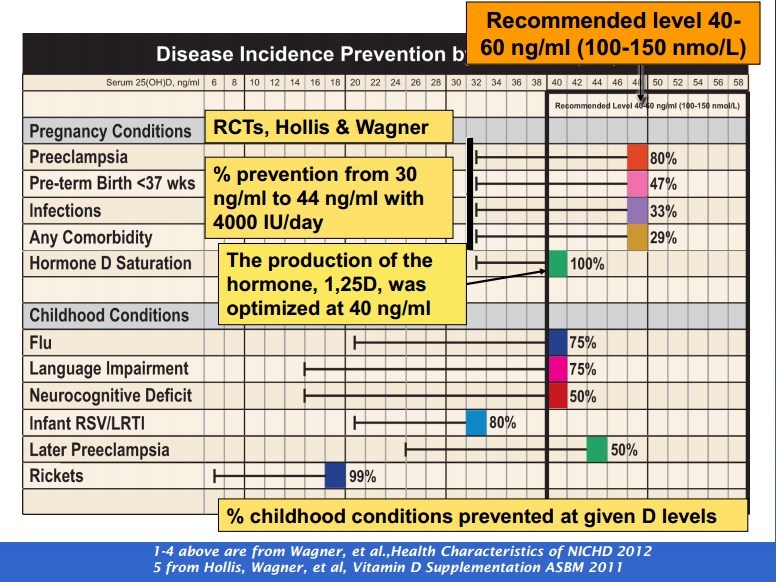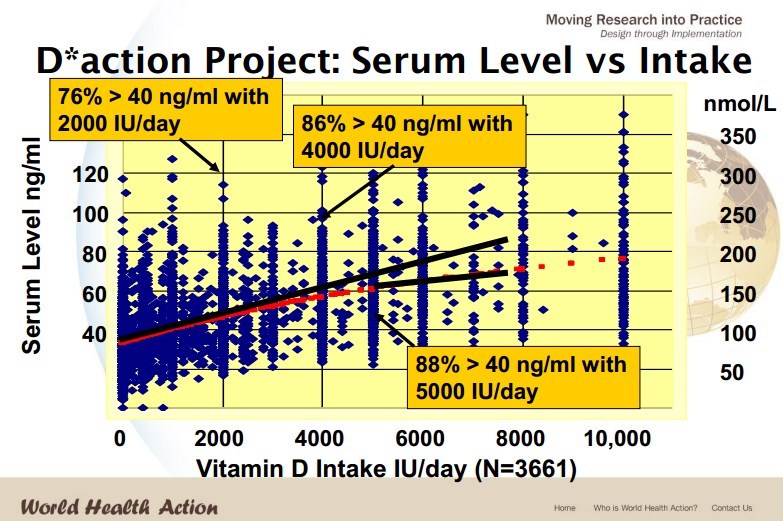Vitamin D Webinar - cost of pre-term birth etc- Baggerly
📄 Download the PDF from VitaminDWiki
40 minute video on YouTube
$51,800 = cost of pre-term birth
20 = number needed to treat to prevent one pr-term birth
$ 2590 = Cost savings averaged over 20 pregnancies
VitaminDWiki computes that $80 of prevention would save $51,800 (A 600X Return on Investment)
half as many pre-term births when there is enough Vitamin D
10% of all births are pre-term
Thus, must give vitamin D to 20 women to prevent one pre-term birth
Cost per woman for vitamin D during pregnancy is about $4
Thus $80 ($4 X 20) would save $51,800

Premature Babies Cost Employers $12.7 Billion Annually March Of Dimes Feb 2014
| ** | |||
|---|---|---|---|
| Medical costs | Hospital days | ||
| Healthy | $5,085 | 2 | |
| Preterm and/or LBW | 55,393 | 15 | ** |
Preterm is < 37 weeks, LBW is < 2500 grams
Includes 1 year medical costs of infant, 3 months for mother
Costs adjusted to 2011 from a 2009 survey
Pregnancy great if 40-60 ng of vitamin D

88% of people get > 40 ng with 5,000 IU of vitamin D

See also VitaminDWiki
Pre-term births reduced in half if 40 ng of vitamin D in 3rd trimester – Nov 2014 authors include Bagggerly and Wagner
Preterm infants more likely to have vitamin D levels below 20 ng – Feb 2014
No preemie had even 30 ng of vitamin D, lower D associated with more Respiratory Distress – Aug 2013
Pregnancy category listing has items along with related searches
Pre-term birth - many of risk factors are associated with low vitamin D
Pregnant women will get Vitamin D – going beyond clinical trials - March 2015 project by Wagner and Baggerly
Chance of preterm birth is strongly associated with low vitamin D – Feb 2015
Premature birth 2.5X more likely if mother had low vitamin D and was having twins – July 2013
Preemies 2.5 X more likely to get hip replacement etc. (low vitamin D) – Nov 2014
Preterm birth 30 percent more likely if low vitamin D – meta-analysis May 2016
Search VitaminDWiki for Pre-term 1500 items as of Feb 2015
Extreme preterm infants need a total of 1,000 IU of vitamin D daily – RCT April 2016
See also MarchOfDimes
Your premature baby What health problems can premature babies have after birth?
Apnea. This is a pause in breathing for 20 seconds or more. Premature babies sometimes have apnea. It may happen together with a slow heart rate.
Respiratory distress syndrome (RDS). This is a breathing problem most common in babies born before 34 weeks of pregnancy. Babies with RDS don’t have a protein called surfactant that keeps small air sacs in the lungs from collapsing.
Intraventricular hemorrhage (IVH). This is bleeding in the brain. It usually happens near the ventricles in the center of the brain. A ventricles is a space in the brain that’s filled with fluid.
Patent ductus arteriosis (PDA). This is a heart problem that happens in the connection (called the ductus ateriosus) between two major blood vessels near the heart. If the ductus doesn’t close properly after birth, a baby can have breathing problems or heart failure. Heart failure is when the heart can’t pump enough blood.
Necrotizing enterocolitis (NEC). This is a problem with a baby’s intestines. It can cause feeding problems, a swollen belly and diarrhea. It sometimes happens 2 to 3 weeks after a premature birth.
Retinopathy of prematurity (ROP). This is an abnormal growth of blood vessels in the eye. ROP can lead to vision loss.
Jaundice. This is when a baby's eyes and skin look yellow. A baby has jaundice when his liver isn't fully developed or isn't working well.
Anemia. This is when a baby doesn’t have enough healthy red blood cells to carry oxygen to the rest of the body.
Bronchopulmonary dysplasia (BPD). This is a lung condition that can develop in premature babies as well as babies who have treatment with a breathing machine. Babies with BPD sometimes develop fluid in the lungs, scarring and lung damage.
Infections. Premature babies often have trouble fighting off germs because their immune systems are not fully formed. Infections that may affect a premature baby include pneumonia, a lung infection; sepsis, a blood infection; and meningitis, an infection in the fluid around the brain and spinal cord.
Not mentioned: death
